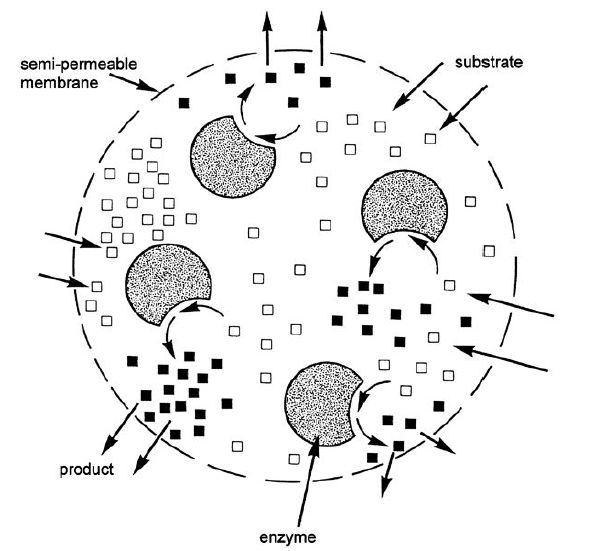


 النبات
النبات
 الحيوان
الحيوان
 الأحياء المجهرية
الأحياء المجهرية
 علم الأمراض
علم الأمراض
 التقانة الإحيائية
التقانة الإحيائية
 التقنية الحيوية المكروبية
التقنية الحيوية المكروبية
 التقنية الحياتية النانوية
التقنية الحياتية النانوية
 علم الأجنة
علم الأجنة
 الأحياء الجزيئي
الأحياء الجزيئي
 علم وظائف الأعضاء
علم وظائف الأعضاء
 الغدد
الغدد
 المضادات الحيوية
المضادات الحيوية|
Read More
Date: 5-1-2021
Date: 8-1-2021
Date: 5-1-2021
|
Encapsulation
Encapsulation of enzymes and or cells can be achieved by enveloping biological components within various forms of semi-permeable membrane . It is similar to entrapment in that enzymes/cells are free in solution, but restricted in space. Large proteins or enzymes cannot pass out of or into the capsule, but small substrates and products can pass freely across the semipermeable membrane. Many materials have been used to construct microcapsules varying from 10 to 100 mm in diameter and nylon membranes and cellulose nitrate membranes have proved popular.
Problems associated with diffusion of substrates in/products out are more acute and can result in rupture of a membrane if products from a reaction accumulate rapidly (Figure 1.). A further problem may arise if an immobilised biocatalyst particle has a density fairly similar to that of the bulk solution and therefore ‘floats’ in the solution. This can cause process problems and may require reassessment of reactor configuration, flow dynamics, etc.
It is also possible to use biological cells as capsules and a notable example of this is the use of erythrocytes (red blood cells). The membrane of an erythrocyte is normally only permeable to small molecules. However, when erythrocytes are placed in a hypotonic solution they swell up and the cell membrane stretches and increases membrane permeability.

Figure 1. Immobilisation in a semipermeable enzyme depicting some of the problems associated with diffusion of substrate into and product out of the structure.
In this condition, erythrocyte proteins diffuse out of the cell and enzymes can diffuse into the cell. Returning swollen erythrocytes to an isotonic solution allows the cell membrane to return to normal and trapped enzymes inside the cell do not leak out. Recent work has used a filamentous fungus to entrap yeast cells in an arrangement that represents a forced symbiosis with modification of growth media to supply a particular carbon source that can only be used by the fungus.



|
|
|
|
مخاطر عدم علاج ارتفاع ضغط الدم
|
|
|
|
|
|
|
اختراق جديد في علاج سرطان البروستات العدواني
|
|
|
|
|
|
|
مدرسة دار العلم.. صرح علميّ متميز في كربلاء لنشر علوم أهل البيت (عليهم السلام)
|
|
|